NEW YORK (CNN/Money) -
Educational toys are getting top billing this holiday season, alongside the Barbie dolls, singing Elmos and Yu-Gi-Oh trading cards.
Learning toys have been around for decades, but a new generation based on faster, cheaper technology and innovative approaches makes them better teachers and a lot more fun.
Companies like LeapFrog Enterprises (LF: down $0.05 to $30.35, Research, Estimates), V-Tech and Neurosmith all produce new toys that teach children everything from recognizing sounds to geography facts, and the toys have elbowed their way to the top of many industry "hot toys" lists for the holidays.
"There's always been a demand for educational toys. If we go back to the 1980s...everybody wanted Junior to be a rocket scientist by the time he was six months old," said Christopher Byrne, a New York-based independent toy consultant. "It's very fashionable to try to educate kids and make them ahead of where they've been."
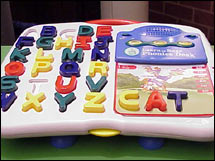 |
|
| Learning toys like the LeapFrog Phonics Desk are hot this year (CNN/File) |
Educational toy sales jumped 77 percent between 2000 and 2001, the strongest growth of any toy category in the industry, according to figures from NPDFunworld, a market research firm in Port Washington, N.Y. In contrast, sales growth for the entire toy industry in 2001 was just one half of a percent.
The renewed clamor for educational toys actually got its start in the 1980s when toy companies started making more realistic baby dolls, Byrne said. That, he said, set off a wave in which companies tried to come up with learning toys that were also fun to play with. However, few turned into blockbusters.
But now, people are waiting longer to have children, which means parents generally have higher incomes than in the past and more time to spend with their kids, and they want the educational toys, NPDFunworld spokeswoman Reyne Rice said.
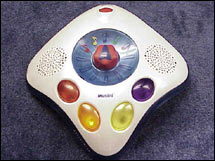 |
|
| Musini by Neurosmith (CNN/File) |
Fisher-Price, the pre-school division of No. 1 toymaker Mattel Inc. (MAT: down $0.08 to $20.07, Research, Estimates), has also long produced educational toys. In fact, LeapFrog's LeapStart Learning Table is reminiscent of Fisher-Price's Intellitable, which has been a popular toy.
"I think kids are naturally curious about their world and exploring, and they want to learn," Byrne said. "I'll be the last person to tell you your child is going to learn to read by playing with a piece of plastic, but as far as reinforcing skills, they're wonderful," he said of the latest crop of learning toys.
LeapFrog produces some of this year's best-selling toys, including the popular LeapPad learning system, which costs $49.99 and teaches young children to read, and the i-Quest handheld that helps high school kids study for tests.
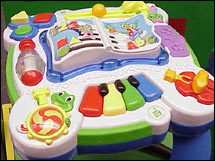 |
|
| LeapStart Learning Table from LeapFrog (CNN/File) |
The LeapStart Learning Table for children ages 6 months and older costs $39.99 and introduces children to musical instrument sounds, the alphabet and numbers.
V-Tech, which has long made learning toys for infants and toddlers, has added a line of toys this year aimed at older children, such as the Smarty's Workshop, a toy worktable for children 3 and older that sells for $59.99. Smarty's toolbox is also available for $24.99.
And Neurosmith, a privately held company that makes educational toys, including Musini, one of this year's top holiday picks, also expects brisk sales.
Musini, which sells for about $59.99, lets children listen to five different musical styles from classical to jazz, set to flashing lights.
"We really try and use technology in a way that makes it invisible but allows a child to explore in their own way and discover things on their own," Neurosmith President Brooke Abercrombie said.
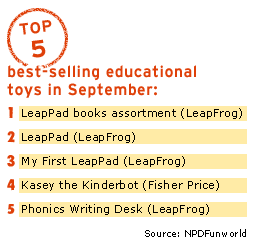
But LeapFrog, in particular its LeapPad Learning System, is undoubtedly helping itself by driving much of the growth in the segment, analysts said.
"Knowing your alphabet is a good thing, but you have to take it and apply it to something else, and LeapFrog really does that," Byrne said. "They've really dominated the market for the past few years."
LeapFrog's stock has surged more than 100 percent since it first went public in July, when its shares traded around $13. Shares of the Emeryville, Calif.-based company flirted with $28 this week after hitting their all-time high of $29.99 on Halloween.
On Oct. 23, LeapFrog posted an 89 percent leap in third-quarter profit from the year-earlier period, handily beating Wall Street estimates. This in spite of more cautious consumer spending amid a shaky economy.
Sales of its core LeapPad learning system helped drive strong quarterly sales.
Toy industry experts are counting the LeapPad, as well as the LeapStart Learning Table for Pre-schoolers and the I-Quest, which quizzes older children on various subjects, among the toys likely to be most in demand for the holidays.
"The longer-term theme that is really starting to show some momentum is that you have a company with product lines that address every single age demographic out there," said Deutsche Bank-North America analyst Jeetil Patel.
Patel, who has a "buy" rating on the stock, expects the company to earn 86 cents a share in 2003, meaning its shares are currently trading at 31 times projected earnings. He does not own the stock, but Deutsche Bank was one of the underwriter's for LeapFrog's public offering in July.
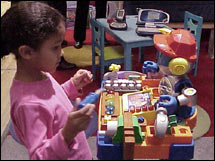 |
|
| Smarty's Workshop by V-Tech (CNN/File) |
LeapFrog has become so popular that school districts in seven states have adopted reading curriculums developed and administered by LeapFrog and featuring LeapFrog products.
The company is also expanding its international presence with offices in London, France, Toronto and Asia. Overseas sales grew nearly 300 percent in the third quarter.
"There is an enormous opportunity to help kids and young adults learn around the world," LeapFrog CEO Mike Wood told CNN/Money in an interview. "I think we will continue to have super-innovative approaches toward learning core subject matters on an ongoing basis in additional subject matters."
Wood, who started the company in 1995 while looking for an effective way to teach his son to read, said the key to maintaining an edge over the competition is to develop compelling software for its core products like the LeapPad and to expand its retail presence.
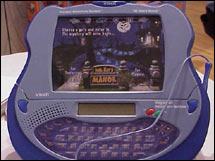 |
|
| V-Tech's Voyager Adventure Station (CNN/File) |
The competition has apparently hurt profits at Japan's V-Tech, which on June 26 reported a 33.5 percent decline in sales of electronic learning toys in fiscal 2002. But the firm, which was one of the first to produce electronic learning toys, has undergone a restructuring and came up with an entirely new line of products to better compete.
"The marketplace has changed quite a bit in the last few years. They've [competitors] made it more difficult to compete," said Jeff Rogers, V-Tech's vice president of marketing.
V-Tech's answer to the competition this year is the Smarty's Workshop and other toys such as the Voyager Adventure Station for children ages 4 to 7 that teaches facts about animals and geography. It costs $49.99. The V-Tech XL Series notebook and hand-held devices for children 5 to 11 teach reading, math and critical thinking skills. Retail prices for the XL line ranges from $149.99 for the ClassMaster Notebook to $39.99 for the SkillStarter Handheld.
As V-Tech's Rogers put it, "It's a matter of taking technology and taking content and putting it in a form kids want to use. But it's not just about technology. It's about making a product that both teaches and entertains kids."

|

